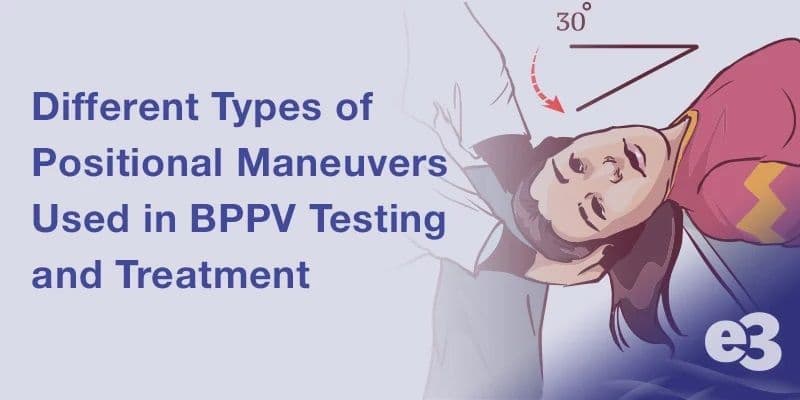Common Positional Maneuvers For BPPV Testing & Treatment

Testing Maneuvers
Dix-Hallpilke
The most common maneuver used in BPPV testing, the Dix-Hallpike assesses involvement of the posterior canal (the most commonly affected semicircular canal). It primarily tests for posterior and anterior canal BPPV, as well as central positional nystagmus.
There are two positions that can be applied during a Dix-Hallpike test. One involves the clinician standing to the side of the patient and the other involves the clinician standing behind the patient. Here’s how the test should go:
- Hold the patient’s head with both hands.
- Ask the patient to lie down so their head is extended 20-30 degrees below the surface.
- Support the weight of the patient’s head and observe the eyes.
- Hold the patient in this position for at least 30 seconds.
- Instruct the patient to sit up with their head turned 45 degrees towards the test ear.
- When they full rise to the seated position, have them maintain their head position while you observe their eyes.
If no nystagmus is seen while sitting or lying with head hanging, then the test is complete for that side, and should be repeated for the other side.
Horizontal Roll Test
Make sure the patient is lying face up.
- Flex the patient’s cervical spine 20-30 degrees.
- Quickly rotate head 45 degrees to the right. Hold position for 30 seconds or until nystagmus and/or other symptoms subside, and then slowly bring patient’s head back to center.
- Repeat on the left side.
- The test is complete, and if nystagmus is present, then the patient is positive.
Head Pitch Test
Make sure the patient is seated.
- Bend the patient’s head forward 30 degrees and assess nystagmus. You should see the nystagmus disappear because the horizontal canal is in a true horizontal position.
- Bend the patient’s head forward to 60 degrees and assess nystagmus. A fast nystagmus may be present. If nystagmus is caused by moving otoconia, it will move toward the affected ear. If the otoconia is connected to the cupula, it will move towards the unaffected ear.
- Bend the patient’s head backwards 30 degrees and assess nystagmus. You may see an increase in nystagmus because the horizontal canal is now vertical.
Treatment Maneuvers
Epley Maneuver
Instruct patient to sit on the edge of a horizontal surface (bed, couch, table etc). Then tell them to turn their head 45 degrees towards the ear where the vertigo is coming from.
- Have them quickly lie down on their back and keep their head on the surface. The head must remain at 45 degrees. Have them hold 30 seconds.
- Then have them turn their head 90 degrees to the right and hold 30 seconds.
- Instruct the patient to turn their head and body on its side to the right so they are looking at the floor. Have them hold for 30 seconds.
- Instruct them to slowly sit up and remain on the surface a few minutes.
Instruct the patient to perform these steps three times before going to bed each night until they’ve gone 24 hours without dizziness.
Semont Maneuver
Another common treatment exercise for BPPV is the Semont Maneuver. Like the Epley Maneuver, this exercise is easy for the patient to do on their own. Here are the steps:
Instruct the patient to sit on the edge of a horizontal surface and turn their head 45 degress towards the ear where the vertigo is coming from.
- Have them quickly lie down on the opposite side of their body and hold for 30 seconds.
- Then instruct them to quickly move to lie down on the opposite end of the surface while keeping their head at 45 degrees. Have them hold for 30 seconds. They should be looking at the floor.
- Have them return slowly to sitting and wait a few minutes.
Again, they should do these steps three times per day until they go 24 hours without vertigo.
Foster Maneuver
While not as commonly used as other exercises, the Foster Maneuver is one of the easiest for patients to perform. Here is how it should be done:
Have the patient kneel on all fours and look up at the ceiling.
- Instruct them to touch the floor with their head, bending their head toward their knees. Have them hold for 30 seconds.
- Tell them to turn their head in the direction of the affected ear and hold for 30 seconds.
- Have them quickly raise their head while keeping it at a 45-degree angle. Have them hold for 30 seconds.
- Then have them quickly raise their head so it’s fully upright, while keeping their head turned to the shoulder of the affected side.
- Instruct the patient to slowly stand up.
Brandt-Daroff Exercise
Lastly, the Brandt-Daroff exercise is another well-known maneuver for treating BPPV symptoms. Here is how it is performed:
Instruct the patient to sit upright on a horizontal surface.
- Have them tilt there head 45 degrees away from the affected side.
- Tell them to move into a side-lying position with their nose pointed up.
- Have them hold this position for about 30 seconds, and then move back to the seated position.
- Repeat on the other side.
These movements should be performed ten to fifteen times in a session per day. The patient should continue to do the exercises for 2 weeks or until symptoms go away for 2 days.
References
https://www.webmd.com/brain/home-remedies-vertigo#1-2
https://www.hopkinsmedicine.org/health/conditions-and-diseases/benign-paroxysmal-positional-vertigo
